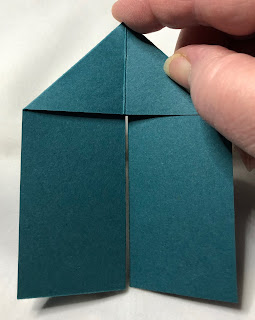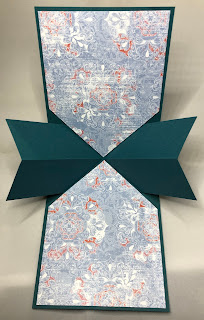I made it to the end of the month! I missed two days through illness but I managed to make 96 cards this month. That'll keep me going for a while! Thank you for following my journey through this month. I hope you got some good ideas from my efforts.
To finish off the challenge I've made some Impossible Cards. These are a fun card that has an auto-pop-up piece on it. It lays flat in an envelope, but pops up with a message when removed from the envelope. I have featured this in my blog previously, but I've revised the instructions a little so I'll give them to you again below.
Card 1
I used Texture Chic Specialty Designer Series Paper to make this card. You need to choose paper where the two sides compliment each other as you get to see both sides. I used a sentiment from Friends Are Like Seashells Stamp Set and some cute images from Elephant Parade Stamp Set.
Card 2
This one uses He's the Man Designer Series Paper and embellishments. I made sure to make several male cards during the challenge. The die-cut pieces in this pack made my life a lot easier.
Card 3
This one uses Enjoy the Journey Designer Series Paper and Silly Goose Stamp Set.
Card 4
I finished off with Dandy Designs Designer Series Paper. I hope you managed to get this free pack of paper. Sale-a-Bration ends today and it won't be available after today. I also used Season of Chic Stamp Set again. I stamped the flower, coloured it and cut it out. I used Stampin' Dimensionals for both the flower and the sentiment label on this card. All of the other cards are attached with flat adhesive.
Measurements and Instructions
Coloured Cardstock (card base): Cut 8" x 6", scored in half at 4".
Designer Series Paper, make sure that both sides look good together: Cut 5¾" x 3¾".
1. Stamp a sentiment onto a piece of scrap cardstock and cut/punch it out.
2. Take the DSP, score at 1⅞" and fold in half longways. Whichever side of the DSP that you want for the pop-up bit, place that side out when you fold this piece.
3. Place the DSP upside down (if it matters) and cut at 2⅞" (i.e. the middle) from the scored fold to the edge of the DSP. On the opposite side cut at 1¼" from each end from the fold to the edge, as shown below.
4. Twist the piece so that you have the following shape (with the pop-up piece in the middle as well).
5. Attach this piece to the card piece. The piece can be twisted in either direction to place the 'opening' on the left or the right. Don't put any adhesive on the pop-up piece.
6. Attach the label to the pop-up piece using flat adhesive or Stampin' Dimensionals.
7. Embellish as desired.
If your DSP isn't stiff enough, I have an alternate method in my previous blog: Impossible Card (scroll down to the end).
And that ends my February Card Challenge. Thank you for joining me. I really enjoyed it and will probably miss it tomorrow, but for now I'm happy for it to be done. I may do something similar in September and make a bunch of Christmas cards.
Happy crafting.































































